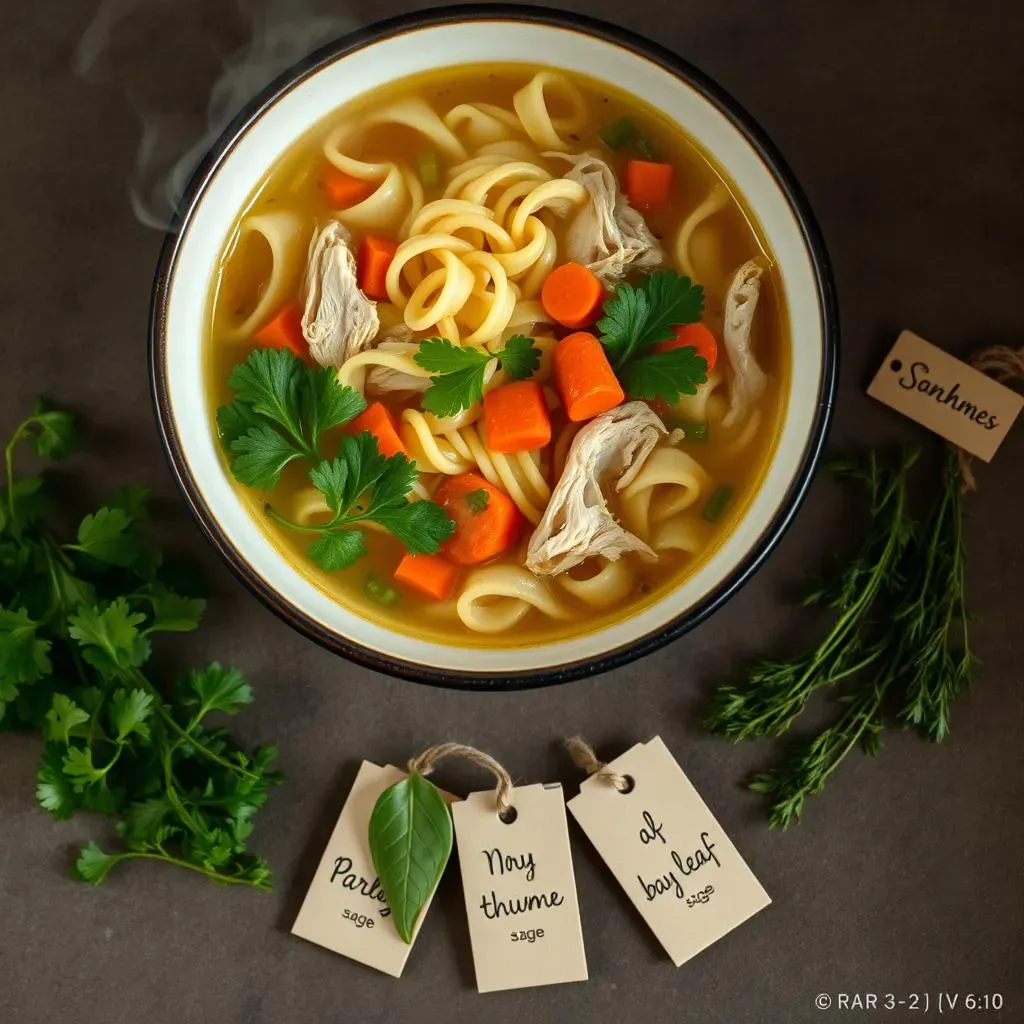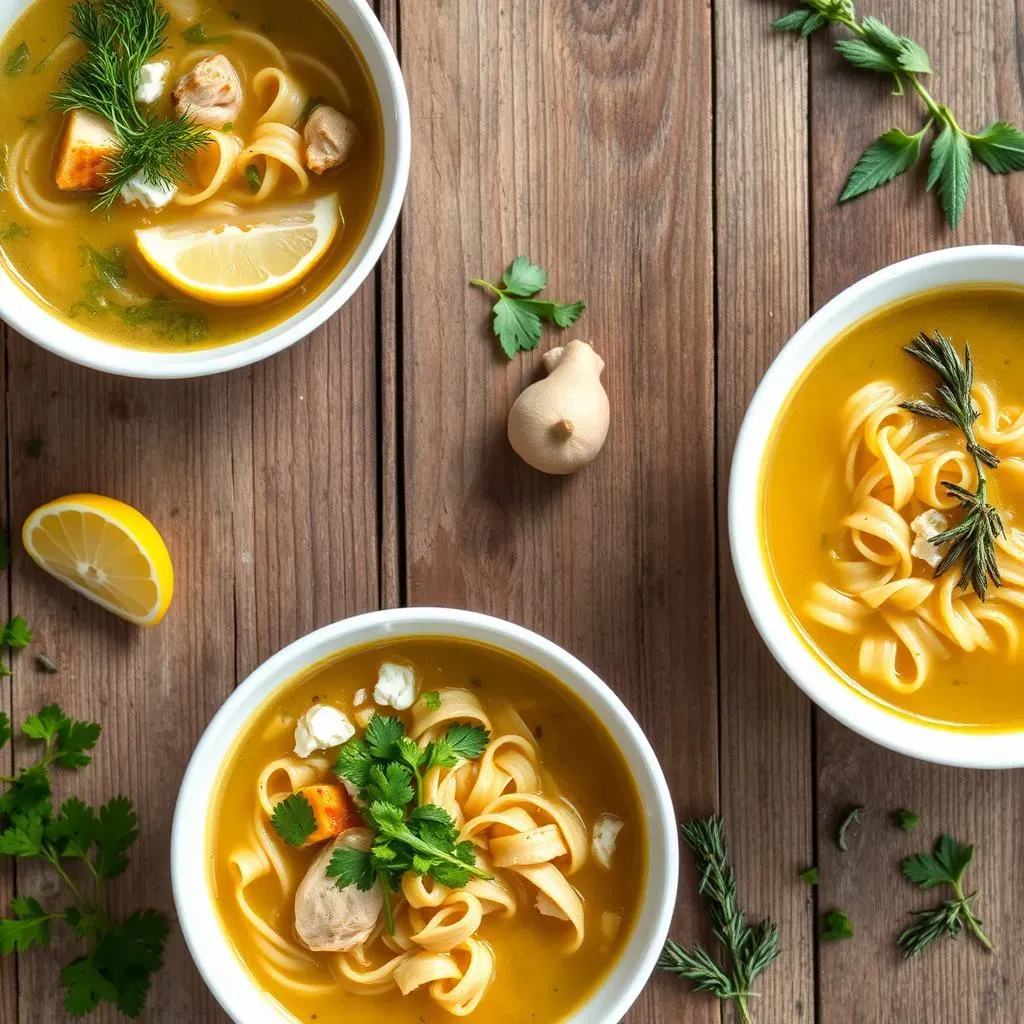Table of Contents
Craving a bowl of soul-soothing chicken noodle soup? Forget the bland, store-bought stuff! The secret to an unforgettable bowl lies in mastering the art of using fresh, fragrant chicken noodle soup recipe herbs. We're not just talking about a sprinkle of dried parsley here; we're diving deep into the world of herbaceous flavors that can elevate your soup from ordinary to extraordinary.
The Best Herbs for Chicken Noodle Soup: Aromatic Essentials

The Best Herbs for Chicken Noodle Soup: Aromatic Essentials
Classic Chicken Noodle Soup Herbs
When it comes to chicken noodle soup, certain herbs are practically synonymous with the dish. These are your foundational flavors, the ones that evoke that comforting, home-style taste we all crave. Think of them as the reliable building blocks upon which you can construct your own unique herbal symphony.
First, there's parsley, the unsung hero of the herb world. Its mild, slightly grassy flavor adds a fresh, clean note that brightens the entire soup. Then comes thyme, with its earthy, slightly lemony aroma that infuses the broth with warmth. Bay leaf is another must-have, adding a subtle depth and complexity that you might not even notice is there – until it's missing! Finally, a touch of sage brings a savory, slightly peppery element that rounds out the flavor profile beautifully.
Herb | Flavor Profile | Best Time to Add |
|---|---|---|
Parsley | Fresh, grassy | End of cooking |
Thyme | Earthy, lemony | Early in cooking |
Bay Leaf | Subtle, complex | Simmering broth |
Sage | Savory, peppery | Mid-cooking |
Beyond the Usual Suspects: Expanding Your Herbal Horizon
While parsley, thyme, bay leaf, and sage are fantastic starting points, don't be afraid to experiment! The world of herbs is vast and exciting, and there are countless ways to customize your chicken noodle soup to your liking. Consider adding rosemary for a piney, resinous note that pairs beautifully with chicken. Or try a sprinkle of marjoram for a sweeter, more floral flavor.
For a bolder, more vibrant twist, consider adding a touch of fresh oregano or even a pinch of dried tarragon. And if you're feeling adventurous, why not incorporate some more unusual herbs like lemon balm or chervil? The possibilities are truly endless! Just remember to start with small amounts and taste as you go, adjusting the flavors until you achieve your perfect herbal blend.
Crafting Your Chicken Noodle Soup: StepbyStep with Herbs

Crafting Your Chicken Noodle Soup: StepbyStep with Herbs
Building the Base: The Broth and Mirepoix
First things first, let's talk broth. The quality of your broth will significantly impact the overall flavor of your soup, so opt for a good-quality store-bought broth or, better yet, make your own! If you're using store-bought, look for low-sodium varieties so you can control the saltiness yourself. While the broth simmers, let's tackle the mirepoix – that's the fancy French term for the aromatic base of onions, carrots, and celery. Sauté these veggies in a bit of olive oil until they're softened and fragrant. This step is crucial for building depth of flavor in your soup.
Now, here's where the herbal magic begins. Add your hardier herbs like thyme and bay leaf to the mirepoix as it cooks. Sautéing these herbs in oil releases their essential oils, infusing the entire base with their aromatic goodness. Think of it as creating an herbal foundation upon which you'll build the rest of your soup.
Adding Chicken and Noodles: Timing is Everything
Once your mirepoix is ready and your broth is simmering, it's time to add the chicken. You can use cooked chicken that you've shredded or cubed, or you can poach raw chicken directly in the broth. If poaching, be sure to remove the chicken once it's cooked through and shred it before adding it back to the soup. This ensures that the chicken stays tender and doesn't dry out.
Next up are the noodles. The type of noodles you use is entirely up to you, but egg noodles are a classic choice for chicken noodle soup. Add the noodles according to package directions, keeping in mind that they will continue to cook slightly even after you remove the soup from the heat. Be careful not to overcook the noodles, as they can become mushy and detract from the overall texture of the soup.
Ingredient | Timing | Why |
|---|---|---|
Hardy Herbs (Thyme, Bay Leaf) | With Mirepoix | Infuse the base with flavor |
Chicken | After Mirepoix | Cooks in the flavorful broth |
Noodles | According to package directions | Avoid overcooking |
Delicate Herbs (Parsley) | End of Cooking | Maintain fresh flavor |
Finishing Touches: Fresh Herbs and Final Seasoning
With the chicken and noodles cooked to perfection, it's time for the final flourish – the fresh herbs! This is where you'll add your more delicate herbs like parsley, which are best added at the very end of cooking to preserve their bright, fresh flavor. Simply stir in the chopped parsley just before serving, and watch as it transforms the soup with its vibrant green hue and refreshing aroma.
Finally, taste the soup and adjust the seasoning as needed. Add salt and pepper to taste, and don't be afraid to experiment with other seasonings like garlic powder, onion powder, or even a pinch of red pepper flakes for a touch of heat. Remember, the goal is to create a soup that is perfectly balanced and bursting with flavor!
Beyond the Basics: Herb Variations in Chicken Noodle Soup Recipe

Beyond the Basics: Herb Variations in Chicken Noodle Soup Recipe
Mediterranean Sunshine: A Greek-Inspired Twist
Dreaming of sun-drenched shores and the vibrant flavors of the Mediterranean? Infuse your chicken noodle soup with a Greek-inspired twist by incorporating herbs like oregano, dill, and a touch of mint. Oregano brings a robust, earthy flavor, while dill adds a delicate, slightly anise-like note. The mint provides a refreshing coolness that balances the richness of the broth. A squeeze of lemon juice at the end will further enhance the Mediterranean vibe, creating a bright and flavorful soup that's perfect for a light lunch or dinner.
For an extra layer of flavor, consider adding a pinch of dried red pepper flakes for a subtle kick. And don't forget the feta! A sprinkle of crumbled feta cheese on top adds a salty, tangy element that complements the herbs beautifully. This variation is a delicious way to transport your taste buds to the sunny shores of Greece, all in a single bowl of comforting chicken noodle soup.
Asian Aromatics: An Eastern-Inspired Elixir
Venture east with your chicken noodle soup by incorporating Asian-inspired herbs like cilantro, ginger, and lemongrass. Cilantro offers a bright, citrusy flavor, while ginger adds a warm, spicy kick. Lemongrass provides a subtle lemon-lime aroma that's both refreshing and invigorating. These herbs create a complex and aromatic broth that's both comforting and exotic.
To further enhance the Asian flavors, consider adding a splash of soy sauce or fish sauce for umami, and a drizzle of sesame oil for richness. You can also incorporate vegetables like bok choy, shiitake mushrooms, or bamboo shoots for added texture and flavor. This variation is a delicious way to explore the diverse flavors of Asia, all in a single bowl of comforting chicken noodle soup.
Herb | Flavor Contribution | Complementary Ingredients |
|---|---|---|
Cilantro | Bright, citrusy | Lime, soy sauce |
Ginger | Warm, spicy | Sesame oil, mushrooms |
Lemongrass | Lemon-lime aroma | Coconut milk, chili |
Earthy & Robust: A Tuscan Herb Garden
Imagine yourself in a Tuscan herb garden, surrounded by the earthy aromas of rosemary, sage, and oregano. Capture this rustic essence in your chicken noodle soup by using these robust herbs. Rosemary lends a piney, resinous note, while sage adds a savory, slightly peppery flavor. Oregano provides a warm, slightly bitter undertone that balances the other herbs beautifully.
For a truly authentic Tuscan experience, use high-quality olive oil to sauté the mirepoix and herbs. Consider adding other Italian-inspired ingredients like cannellini beans, diced tomatoes, or a sprinkle of Parmesan cheese. This variation is a hearty and flavorful way to bring the taste of Tuscany to your table, all in a single bowl of comforting chicken noodle soup.
Tips and Tricks: Maximizing Herb Flavor in Chicken Noodle Soup

Tips and Tricks: Maximizing Herb Flavor in Chicken Noodle Soup
Fresh vs. Dried: Knowing When to Use Which
let's get real about herbs. Fresh herbs are fantastic, no doubt. They bring a vibrant, bright flavor that's hard to beat. But dried herbs have their place too! The key is knowing when to use which. Generally, fresh herbs are best added towards the end of cooking, as their delicate flavors can dissipate with prolonged heat. Dried herbs, on the other hand, benefit from being added earlier in the cooking process, allowing their flavors to fully infuse the broth.
Think of it this way: fresh herbs are like a final flourish, a burst of freshness that awakens the palate. Dried herbs are like a slow burn, building a foundation of flavor that permeates the entire soup. As a rough guide, use about one-third the amount of dried herbs as you would fresh herbs. So, if a recipe calls for 1 tablespoon of fresh parsley, you'd use about 1 teaspoon of dried parsley. But honestly, taste as you go and adjust to your liking! There aren't any hard and fast rules here, just guidelines to help you create the most flavorful soup possible.
Herb Type | Flavor Profile | Best Time to Add | Ratio (Dried to Fresh) |
|---|---|---|---|
Fresh | Bright, vibrant | End of cooking | 3:1 (Fresh:Dried) |
Dried | Earthy, concentrated | Early in cooking | 1:3 (Dried:Fresh) |
Blooming Your Herbs: Unlocking Maximum Flavor
Want to take your herb game to the next level? Try blooming your herbs! This simple technique involves gently heating your dried herbs in a bit of oil or butter before adding them to the soup. This helps to release their essential oils, intensifying their flavor and aroma. Simply heat a tablespoon or two of olive oil or butter in a pan over medium heat, then add your dried herbs and cook for about a minute, until fragrant. Be careful not to burn the herbs! Then, add the bloomed herbs to your soup and prepare for a flavor explosion.
For fresh herbs, you can achieve a similar effect by gently bruising them before adding them to the soup. This helps to release their oils and aromas, making them even more flavorful. Simply crush the herbs lightly with your hands or a mortar and pestle before adding them to the soup. This is especially effective with herbs like rosemary and thyme, which have tough leaves that can be difficult to break down.
Herb Combinations: Creating Flavor Harmony
Choosing the right herb combinations is crucial for creating a balanced and flavorful chicken noodle soup. Some herbs naturally complement each other, while others can clash if not used carefully. As a general rule, stick to a maximum of 3-4 herbs in your soup, unless you're going for a more complex, multi-layered flavor profile. Start with a base of classic herbs like parsley, thyme, and bay leaf, then add one or two additional herbs to customize the flavor to your liking.
For example, if you're going for a Mediterranean-inspired soup, combine oregano, dill, and mint. If you're craving Asian flavors, try cilantro, ginger, and lemongrass. And if you're in the mood for something earthy and robust, combine rosemary, sage, and oregano. The possibilities are endless! Just remember to taste as you go and adjust the herb combinations until you achieve your perfect flavor harmony.
- Mediterranean: Oregano, dill, mint
- Asian: Cilantro, ginger, lemongrass
- Tuscan: Rosemary, sage, oregano
Conclusion: Your Herb-Infused Chicken Noodle Soup Awaits
Armed with this guide to chicken noodle soup recipe herbs, you're now ready to create a truly exceptional and comforting dish. Experiment with different combinations, adjust the quantities to your liking, and don't be afraid to get creative! Whether you prefer the classic blend of thyme, rosemary, and parsley, or a more adventurous mix with sage and bay leaf, the possibilities are endless. So, gather your herbs, simmer your broth, and prepare to savor a bowl of chicken noodle soup that's bursting with fresh, vibrant flavor. Enjoy!
